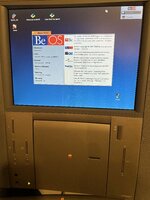So, I recently learned that the TAM (Twentieth Anniversary Mac) can run BeOS. The person who was running it said you can run BeOS Pro on the TAM, so I figured I'd give it a go. Well, similar to my challenging experience getting it installed on my PowerMac 6400, I struggled a bit and figured it would be good to document my challenges and how I ultimately ended up getting it installed.
The main challenge I've seemed to have is getting machines to recognize the BeFS partitions on the CDs.
First, if you are planning on burning the BeOS CDs, I recommend using the .bin/.cue versions here. And using an old Windows machine with a CD burner at slow speeds to increase your chances of success. Don't use the .iso. I don't think it properly sets up the multiple partitions.
I believe you also need to run MacOS 7/8 to get the OS chooser to work properly. Also, it helps if you have unpartitioned space on your hard drive (or a dedicated HD). I was never able to get the TAM to recognize the CD in the BeOS boot loader. However, the CD was fine because I was able to run it on my 6400. After many attempts, I had a thought that I should try creating a blank 2GB drive on my RaSCSI, see if I could install onto that, and then plug the RaSCSI into the TAM and see if the BeOS Boot loader recognized it. So, I initialized the RaSCSI HD image in the BeOS Drive Setup app, then installed 5.0.3 to it. I booted the 6400 from the RaSCSI to ensure it was functional, then connected it up to the TAM. And it worked!
Pretty cool to see the TAM running BeOS.
So, if you are wondering, BeOS supports install onto SCSI drives (somehow I had gotten it into my head that it only could be installed on the IDE drive). And RaSCSI worked perfectly with it.
Next, I need to get some mp3s loaded onto it and hear them in the fantastic sound system.
Also, I am going to download the HDA and throw it on a BlueSCSI and see if that works. If so, I could probably upload the BeOS image somewhere to save people the trouble of the install. Just download the HDA, throw it on a SD card, add the _OS Chooser_ extension to your system folder, and reboot. Will let you know how the test goes.
The main challenge I've seemed to have is getting machines to recognize the BeFS partitions on the CDs.
First, if you are planning on burning the BeOS CDs, I recommend using the .bin/.cue versions here. And using an old Windows machine with a CD burner at slow speeds to increase your chances of success. Don't use the .iso. I don't think it properly sets up the multiple partitions.
I believe you also need to run MacOS 7/8 to get the OS chooser to work properly. Also, it helps if you have unpartitioned space on your hard drive (or a dedicated HD). I was never able to get the TAM to recognize the CD in the BeOS boot loader. However, the CD was fine because I was able to run it on my 6400. After many attempts, I had a thought that I should try creating a blank 2GB drive on my RaSCSI, see if I could install onto that, and then plug the RaSCSI into the TAM and see if the BeOS Boot loader recognized it. So, I initialized the RaSCSI HD image in the BeOS Drive Setup app, then installed 5.0.3 to it. I booted the 6400 from the RaSCSI to ensure it was functional, then connected it up to the TAM. And it worked!
Pretty cool to see the TAM running BeOS.
So, if you are wondering, BeOS supports install onto SCSI drives (somehow I had gotten it into my head that it only could be installed on the IDE drive). And RaSCSI worked perfectly with it.
Next, I need to get some mp3s loaded onto it and hear them in the fantastic sound system.
Also, I am going to download the HDA and throw it on a BlueSCSI and see if that works. If so, I could probably upload the BeOS image somewhere to save people the trouble of the install. Just download the HDA, throw it on a SD card, add the _OS Chooser_ extension to your system folder, and reboot. Will let you know how the test goes.

